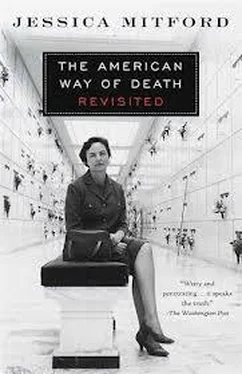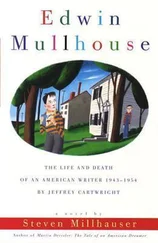At this point the black suits rose up, all twelve of them, and walked out. I was expecting people to follow because we were, after all, in the Bible Belt. Deep Bible Belt in Vidalia, Georgia. But rather to my pleasure, not a soul stirred. They were all keen to discuss their mother’s funeral.
Cemeteries now compete with the funeral directors for the lucrative vault business. Most require the use of vaults in all burials for the ostensible reason that the vault prevents the caving in of the grave due to the eventual disintegration of the casket. The selling point made to the customer is, of course, the eternal preservation of the dead. It seems that the Midwest is a particularly fruitful territory for the sale of metal vaults. “Must be the psychological reason brought about by thoughts of extreme heat and cold, stormy weather, snow and frozen ground,” muses Mortuary Management .
An appropriate showcase setting for all these treasures assumes a special importance. Gone forever are the simple storefront undertaking establishments of earlier days. They have been replaced by elaborate structures in the style of English country houses, French provincial châteaux, Spanish missions, split-level suburban executive mansions, or Byzantine mosques—frequently, in a freewheeling mixture of all these. A Gothic chapel may be carpeted with the latest in wall-to-wall, two-inch-thick, extra-pile Acrilan, and Persian rugs laid on top of this; its bronze-girt door may open onto an authentically furnished Victorian drawing room in one corner of which is a chrome-and-tile coffee bar. The slumber rooms in the same building may stress the light and airy Swedish modern motif.
The funeral home “chapel” has begun to assume more and more importance as the focal point of the establishment. In fact, many now call themselves “chapels.” The nomenclature has gradually changed. From “undertaker” to “funeral parlor” to “funeral home” to “chapel” has been the linguistic progression; “chapel” has the additional advantage of circumventing the word “funeral.” Chapel of the Chimes, Chapel of Memories, Little Chapel of the Flowers—these are replacing Snodgrass Funeral Home. The chapel proper is a simulated place of worship. Because it has to be all things to all people, it is subject to a quick change by wheeling into place a “devotional chapel set” appropriate to the religion being catered to at the moment—a Star of David, a cross, a statue of the Virgin, and so on. Advertisements and promotional brochures generally emphasize the chapel and its features: “Enter the chapel. Note how the sun pours its diffused glory through Gothic windows, and how the blue and amber, ruby and amethyst tones of glass play smilingly on walls and ceiling …” (Chapel of the Chimes brochure).
The slumber rooms are elusively reminiscent of some other feature of American life. What familiar establishments also boast such eclecticism of design, from medieval to futuristic, combined with the most minute attention to comfort? In what category of building are you sure to find voluptuous carpeting underfoot, floor-length draw drapes, skillfully arranged concealed lighting to please the eye, temperature expertly adjusted by push button for maximum well-being—the soothing atmosphere of restful luxury pervading all? The answer was suggested by a funeral director with whom I was discussing costs. He was explaining the items that go to make up a total. “So then you’ve got a slumber room tied up for three days or more,” he said. “Right there’s a consideration: How much would it cost you to stay in a good motel for three days?”
Motels for the dead! That’s it, of course—a swimming pool and TV the only missing features.
The selection room is the portion of the mortuary where the caskets are displayed and offered for sale. It is here that all of the previous efforts of the funeral director—his advertising, his living the good life in the community, the impression he has made on the bereaved family during the arrangement conference—will be crowned with success or doomed to failure. It is here that the actual price of the funeral will be settled.
The decor and lighting of the selection room and particularly the arrangement of merchandise are matters of greatest importance, for these, as we have seen, materially condition and affect the conduct of the transaction itself. As an interior decorator writes, “Being the financial foundation of mortuary income, caution should be exercised in every detail and appointment, employing the finest selling qualities of color lighting effects, proper placement of caskets and special background features; the psychological effect producing a feeling of security and confidence that results in the sale of higher grade caskets, and the return of families for additional service when needed.”
Further on decor, one writer advises that warm colors are said to be advancing colors; and cold colors are receding colors. She recommends cool backgrounds to set off the warm walnut, mahogany, copper shades of the caskets. Another prefers touches of red about the place, possibly decorative wallpaper panels, and a bone-white ceiling to give a good distribution of light. The matter of good lighting is most important because in dim light it is hard to distinguish between low-grade rayon and transparent velvet casket linings. Throughout, “color, life and light” will provide the right atmosphere for people “conditioned to modern environment.” A minimum of forty square feet of floor space is needed to display a burial casket, although if possible sixty square feet should be allowed for each unit.
We have glimpsed the chapel, the slumber rooms, the casket-selection room, all designed for public inspection and edification. We have examined some of the choice and curious artifacts and their uses. There is one door we have not yet opened, through which the public may not enter and behind which certain procedures take place—procedures indispensable to the proper utilization of the funeral director’s merchandise and premises. What goes on in that forbidden territory, and why, can only be understood in context if we “weave in the service story.”
There was a time when the undertaker’s tasks were clear-cut and rather obvious, and when he billed his patrons accordingly. Typical late-nineteenth-century charges, in addition to the price of merchandise, are shown on bills of the period as: “Services at the house (placing corpse in the coffin), $1.25,” “Preserving remains on ice, $10,” “Getting permit, $1.50.” It was customary for the undertaker to add a few dollars to his bill for being “in attendance,” which seems only fair and right. The cost of embalming was around $10 in 1880. An undertaker, writing in 1900, recommends these minimums for service charges: washing and dressing, $5; embalming, $10; hearse, $8 to $10. As Robert W. Habenstein and William M. Lamers, the historians of the trade, have pointed out, “The undertaker had yet to conceive of the value of personal service offered professionally for a fee, legitimately claimed.” Well, he has now so conceived with a vengeance.
When weaving in the story of service as it is rendered today, spokesmen for the funeral industry tend to become so carried away by their own enthusiasm, so positively lyrical and copious in their declarations, that the outsider may have a little trouble understanding it all. There are indeed contradictions. Preferred Funeral Directors International has prepared a talk designed to inform people about service: “The American public receive the services of employees and proprietor alike, nine and one half days of labor for every funeral handled, they receive the use of automobiles and hearses, a building including a chapel and other rooms which require building maintenance, insurance, taxes and licenses, and depreciation, as well as heat in the winter, cooling in the summer, light and water.” The writer goes on to say that while the process of embalming takes only about three hours, “it would be necessary for one man to work two forty-hour weeks to complete a funeral service. This is coupled with an additional forty hours of service required by members of other local allied professions, including the work of the cemeteries, newspapers, and, of course, the most important of all, the service of your clergyman. These some 120 hours of labor are the basic value on which the cost of funerals rests.”
Читать дальше












